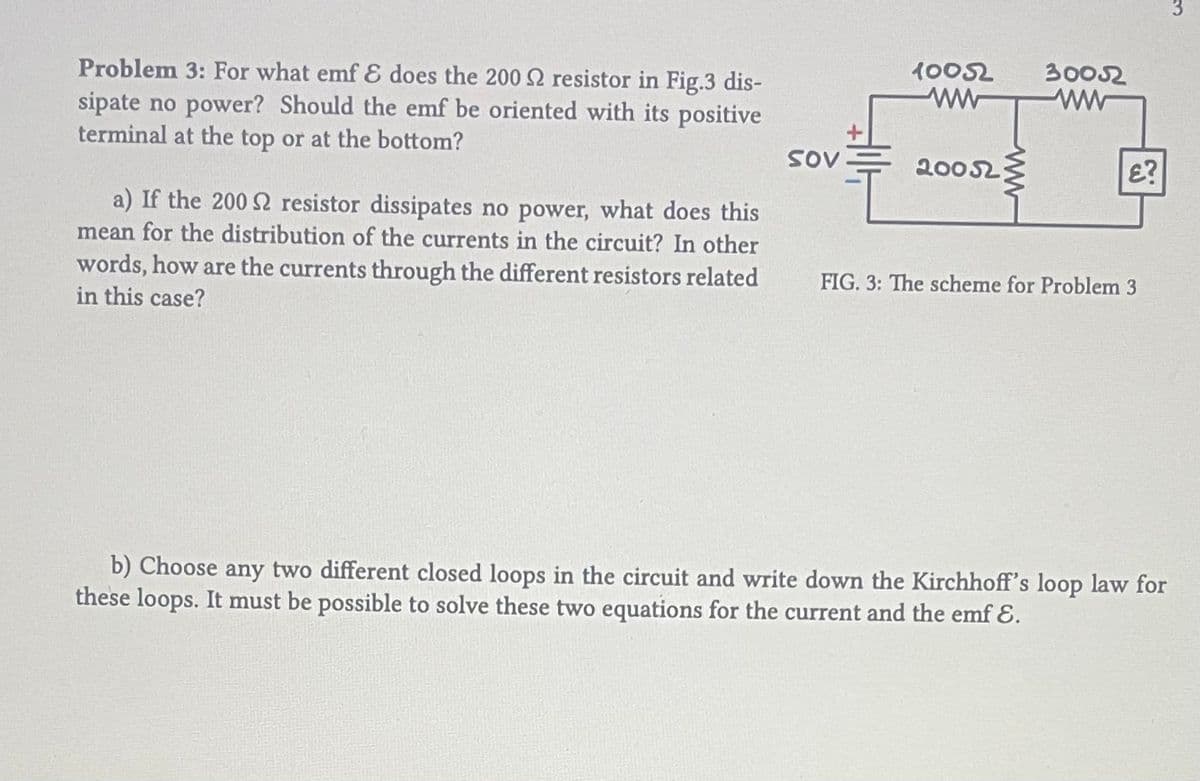Problem 3: For what emf & does the 200 S2 resistor in Fig.3 dis- sipate no power? Should the emf be oriented with its positive terminal at the top or at the bottom? a) If the 200 S2 resistor dissipates no power, what does this mean for the distribution of the currents in the circuit? In other words, how are the currents through the different resistors related in this case? SOV 10052 ww 200523 30052 ww £? FIG. 3: The scheme for Problem 3 b) Choose any two different closed loops in the circuit and write down the Kirchhoff's loop law for these loops. It must be possible to solve these two equations for the current and the emf E.
Problem 3: For what emf & does the 200 S2 resistor in Fig.3 dis- sipate no power? Should the emf be oriented with its positive terminal at the top or at the bottom? a) If the 200 S2 resistor dissipates no power, what does this mean for the distribution of the currents in the circuit? In other words, how are the currents through the different resistors related in this case? SOV 10052 ww 200523 30052 ww £? FIG. 3: The scheme for Problem 3 b) Choose any two different closed loops in the circuit and write down the Kirchhoff's loop law for these loops. It must be possible to solve these two equations for the current and the emf E.
Introductory Circuit Analysis (13th Edition)
13th Edition
ISBN:9780133923605
Author:Robert L. Boylestad
Publisher:Robert L. Boylestad
Chapter1: Introduction
Section: Chapter Questions
Problem 1P: Visit your local library (at school or home) and describe the extent to which it provides literature...
Related questions
Question
Hello, I really need help with Part A and part B because I don't understand it, so they any chance that you help me with part A and part B and also can you label which one is which

Transcribed Image Text:Problem 3: For what emf & does the 2002 resistor in Fig.3 dis-
sipate no power? Should the emf be oriented with its positive
terminal at the top or at the bottom?
a) If the 200 S2 resistor dissipates no power, what does this
mean for the distribution of the currents in the circuit? In other
words, how are the currents through the different resistors related
in this case?
SOV
10052
ww
20052
30052
£?
FIG. 3: The scheme for Problem 3
b) Choose any two different closed loops in the circuit and write down the Kirchhoff's loop law for
these loops. It must be possible to solve these two equations for the current and the emf E.
3
Expert Solution
This question has been solved!
Explore an expertly crafted, step-by-step solution for a thorough understanding of key concepts.
This is a popular solution!
Trending now
This is a popular solution!
Step by step
Solved in 5 steps with 5 images

Recommended textbooks for you

Introductory Circuit Analysis (13th Edition)
Electrical Engineering
ISBN:
9780133923605
Author:
Robert L. Boylestad
Publisher:
PEARSON

Delmar's Standard Textbook Of Electricity
Electrical Engineering
ISBN:
9781337900348
Author:
Stephen L. Herman
Publisher:
Cengage Learning

Programmable Logic Controllers
Electrical Engineering
ISBN:
9780073373843
Author:
Frank D. Petruzella
Publisher:
McGraw-Hill Education

Introductory Circuit Analysis (13th Edition)
Electrical Engineering
ISBN:
9780133923605
Author:
Robert L. Boylestad
Publisher:
PEARSON

Delmar's Standard Textbook Of Electricity
Electrical Engineering
ISBN:
9781337900348
Author:
Stephen L. Herman
Publisher:
Cengage Learning

Programmable Logic Controllers
Electrical Engineering
ISBN:
9780073373843
Author:
Frank D. Petruzella
Publisher:
McGraw-Hill Education

Fundamentals of Electric Circuits
Electrical Engineering
ISBN:
9780078028229
Author:
Charles K Alexander, Matthew Sadiku
Publisher:
McGraw-Hill Education

Electric Circuits. (11th Edition)
Electrical Engineering
ISBN:
9780134746968
Author:
James W. Nilsson, Susan Riedel
Publisher:
PEARSON

Engineering Electromagnetics
Electrical Engineering
ISBN:
9780078028151
Author:
Hayt, William H. (william Hart), Jr, BUCK, John A.
Publisher:
Mcgraw-hill Education,